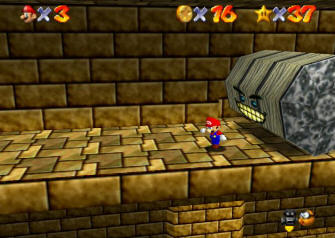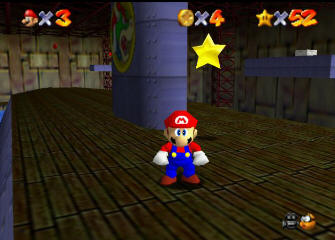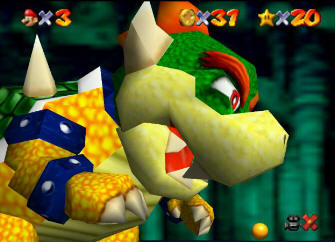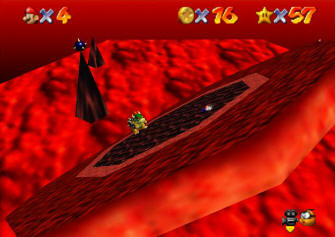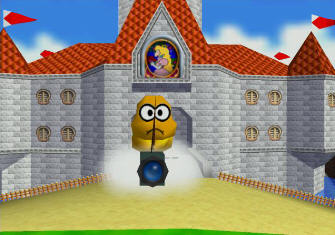 Super Mario 64 is considered one of the greatest games of all time for a very good reason; the game is still a heck of a lot of fun even in the year 2008. Amazing, for a game released in 1996.
Super Mario 64 is considered one of the greatest games of all time for a very good reason; the game is still a heck of a lot of fun even in the year 2008. Amazing, for a game released in 1996.
Super Mario 64 does so much right it’s mind-boggling. Even more so when you consider the fact that it birthed so many firsts and almost exclusively revolutionized the video game industry. The game was one of the first to be in full 3D (it was released before the original Tomb Raider) and the graphics were incredibly impressive, with crisp, vibrant colors.
It basically set the standard for all 3D games to come after it, and made strides in two areas that up until that point hadn’t become standards in the industry: Full analog control (thanks to the control stick built into the Nintendo 64 controller) and user camera control, which allowed the player to not only zoom in and out and look in “first-person”, but also rotate the camera 360 degrees around Mario.
 Many trends were also got their start in Super Mario 64, particularly among 3D mascot and platformer games. Such as the whole collection craze, due to the Stars you have to collect to progress in Super Mario 64, something that even Super Mario Galaxy still retains in the same style. And this craze continued long after Super Mario 64, with even the latest platformers like the Jak & Daxter and Ratchet & Clank franchises containing some type of collectible. Other trends include some of Mario’s moves, such as the wall jump and Mario’s infamous Butt-Stomp move, which made it’s debut here and would be copied by many other games.
Many trends were also got their start in Super Mario 64, particularly among 3D mascot and platformer games. Such as the whole collection craze, due to the Stars you have to collect to progress in Super Mario 64, something that even Super Mario Galaxy still retains in the same style. And this craze continued long after Super Mario 64, with even the latest platformers like the Jak & Daxter and Ratchet & Clank franchises containing some type of collectible. Other trends include some of Mario’s moves, such as the wall jump and Mario’s infamous Butt-Stomp move, which made it’s debut here and would be copied by many other games.
Super Mario 64 has also been rediscovered by new generations of youth with it’s various re-releases. The game so far has been re-released twice: On the Nintendo DS with three additional characters and more Stars to collect on new levels, and most recently in it’s original form on the Wii Virtual Console (where you can play it with either the GameCube or Classic Controllers).
My review below is of the original Nintendo 64 version, because nothing beats playing the game with that special brand of N64 game pad.
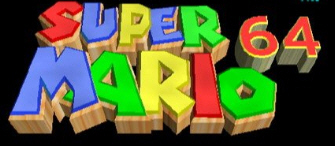
System: Nintendo 64 (N64)
Also On: Wii VC and Nintendo DS (as “Super Mario 64 DS” with additions)
Released: JP June 23, 1996 – USA September 29, 1996 – EU & AUS March 1, 1997
Wii: USA November 19, 2006 – JP December 2, 2006 – AUS December 7 2006 – EU December 8, 2006
Genre: Platformer
Players: 1-Player
Save: 4 Save Files. You can save after collecting a Star
Developer: Nintendo
Publisher: Nintendo
Creator: Shigeru Miyamoto
Origin: Japan
Rating: E for Everyone
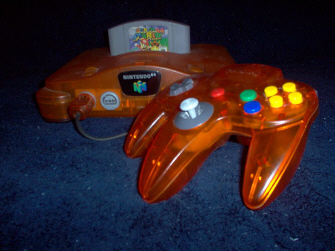
Super Mario 64 has managed to stand the test of time incredibly well. The game is a blast to play whether you are a seasoned veteran like me, or even if it is your first time playing. I recommend playing Super Mario 64 on the Nintendo 64 if you have the means, but if you don’t then it’s fine downloading the game on the Wii Virtual Console as well (or grabbing the DS version, but that one is different). Playing Super Mario 64 with the Nintendo 64 controller offers you the ideal set-up for the game and is the way it was meant to be played. In fact, the Nintendo 64 controller was really built with this game in mind.
From the very intro of the game players were originally astounded way back in 1996. Why? Because Mario speaks! For the first time in the series Mario was given a voice and it couldn’t be more fitting or more classic. By now pretty much everyone can recognize the voice of Mario (who is voiced by Charles Martinet) and the phrase at the start of Super Mario 64, “It’s a-mee, Mario!” has become one of his classic phrases.
The game also had a unique little “mini-game” that you can play as soon as you power it on, and it allows you to mess around with a 3D version of Mario’s face. Using a hand cursor (Mario’s white glove, of course) you can grab onto certain parts of Mario’s face, including his nose, eyes, ears, hat, chin, etc. and you can pull them in any direction. You then can hold that pose (By holding down the R Button) and move around a different part of his face and the previous part that you stretched will stay that way, allowing you to disfigure his face in a number of often hilarious ways. And when you chose to let go of the button Mario’s face will snap back to normal.
On the File Select Screen after pressing Start, you’ll see four game files, as well as buttons for Delete, Copy, Options and Records. Records allows you to look at all the levels in the game and your highest score (coins) for that level.
As soon as you start the game, you are confronted by another first in a Mario game, cut-scenes (although they use in-game graphics not CG). They are only contained at the beginning and ends of the adventure though. This is also where Princess Toadstool got her name change! The opening cut-scene shows the newly modeled Princess who reads you a letter, it says that she has baked a cake for you, and asks Mario to come to the castle. It is signed “Peach” (which she says audibly) and therefore “Princess Peach” or just “Peach” was born.
I remember how outlandish it was back then when I found out they had changed her name from “Princess Toadstool” to “Peach” (her name was always “Peach” in the Japanese Mario games), although it really makes sense, because “Toadstool” isn’t exactly a name. It’s also much easier to simply write or say “Peach” instead of “Princess” or “Princess Toadstool” and it’s one-word, just like all the Mario characters: Mario, Luigi, Toad, Yoshi, Wario, Daisy, Bowser, etc.
After the letter part, the game then cuts to a view of Princess Peach’s castle, where the camera zooms under the bridge and finally to the field in front of the castle, where a pipe appears. Mario then leaps out of it! A short dialog box pops up with a little introduction and tells you to head towards the castle.
I remember how amazing not only the graphics looked at this part, but also how absolutely awesome it was to see the camera fly under the bridge. In 1996, jaws literally dropped at what today looks primitive. Funny how that works.
In the field area outside the castle you can hop around to practice Mario’s somewhat complex moves, a sign (as they do throughout the game) will give you some intro information as well as tell you how to perform said moves. Once you reach the front of the castle you’ll get your first introduction to the game’s camera controls by the Lakitu Bros., who will be your “cameraman” for this adventure. Which is just the game’s way of explaining why you are able to manipulate the camera, which you can do with the four C Buttons. Pressing the C-Up button will zoom closer to Mario while the C Down button moves the camera away from Mario. Pressing the left or right C buttons will rotate the camera in that direction. While pressing the R Button will switch to a different camera mode, either “Mario’s Camera” (which defaults to a REALLY close-up view which is best for crossing narrow ledges) or a “Fixed Camera” (which allows you to keep the camera in place even while you move about, you can set this by pressing Start and going to “Switch Camera Mode with R” and moving it over to “Fixed”). The camera controls are easy to figure out and not hard to use in the least, and controlling your perspective really was a revolution back in 1996.
The rest of the controls are equally as easy although there are enough of them that it can be a bit complex to get a handle on at first, especially if you’ve never played a Mario game before. And unlike in past games, Mario is a true athletic showcase in Super Mario 64, with a myriad of acrobatic moves that allow him to jump and flip all over the 3D worlds in ways never previously dreamed of. And even in 2008 the way you can interact with the world based on Mario’s moves alone still manages to impress.
The flow of the game involves the aforementioned castle, which serves as your hub or connection to the rest of the levels in Super Mario 64. The levels are represented as large paintings that you will find hanging on the walls in various rooms of the castle. And you can get to the game’s 16 stages by jumping into these large paintings. Anything that contains a hidden world will shimmer when you stand next to it.
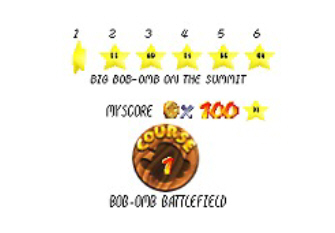
You can choose to play the levels in any order you want. Each level has up to 7 Stars that you can get and each room in the Castle will have a Star on the door that tells you how many Stars you must collect to open that door.
As you progress in the game the number of Stars needed to open doors to further levels will increase. For example, the door to the room to fight Bowser for the first time cost only 8 Stars, but the second Bowser door cost 30 Stars.
Once you’ve entered a level you’ll be shown a Star screen where each of the seven Stars is eventually displayed. The name of the Star shows your goal in that level and also serves as a hint as to how you go about getting the Star. For example, one Star hint says “Chip Off Whomp’s Block”, telling you that the boss “Whomp” holds the Star. Another Star on the same level says “To The Top of the Fortress” and is self-explanatory. Simply climb to the top of the fortress and you’ll get your Star. You can get the Stars in any order you choose, but if you break the order and don’t get the Star it tells you about, then you’ll only see that hint until you get that Star, and then it’ll switch to the next one in order. What this really means is that you’ll be on your own when it comes to finding those Stars other than the one it shows you, so if you follow the hints, then it’ll be easier to get the all the 7 Stars in each level.
If you do choose to get all the Stars in a level though you will have much more than the number of Stars needed to open most doors, and you can even beat the game by earning only 70 out of the total 120 Stars in the game.
The controls and Mario’s plethora of moves that you’ll use in these levels are as described below:
Control Stick: Depending on how far you tilt it Mario will tiptoe, stride, walk, and run.
 A – Jump: The fundamental basis for which the gameplay in Super Mario 64 revolves!
A – Jump: The fundamental basis for which the gameplay in Super Mario 64 revolves!
B – Punch: For the first time in the Mario series the Italian plumber can take out foes with a punch attack.
Z – Crouch: Or “ducking” as it’s known in some circles.
These are the basics from which you will be able to pull of moves like these:
Butt Stomp: When in the air press the Z Button and Mario will pound the ground with his gluteus maximus. This is used to pound stakes or platforms into the ground as well as to destroy enemies.
High Jump: Jump once and just as you land jump again to perform a High Jump. This allows Mario to reach much higher than with a normal jump and is easier to control than the Triple Jump.
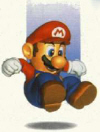 Triple Jump (First jump is normal, second reaches higher, third reaches highest complete with front flip): A, A as you land, A once more. The Triple Jump allows Mario to reach higher than any other jump but can be unwieldly and hard to control due to Mario’s continued flipping on the third jump.
Triple Jump (First jump is normal, second reaches higher, third reaches highest complete with front flip): A, A as you land, A once more. The Triple Jump allows Mario to reach higher than any other jump but can be unwieldly and hard to control due to Mario’s continued flipping on the third jump.
Long Jump: Press Z to crouch then A to jump and Mario will leap much farther than normal.
Back Flip: Hold Z to crouch and press A and Mario will flip backwards.
Side Flip: One of the most innovative moves and one that opens up Mario’s acrobatic ability to a whole new level. Run forward and as you’re running tilt the control stick down (towards Mario’s back) so that he starts to slide a bit before turning around and as he’s sliding press A to jump and Mario will flip in the opposite direction he was going. This moves is crucial for getting up high walls with ease. Although it doesn’t reach as high as the Triple Jump.
Crawl: As you are crouching with Z use the Control Stick and Mario will crawl.
Jump Kick: Without moving press A to jump straight into the air and then press B and Mario will do a jump kick. Very useful to hit flying enemies.
Slide: Run and then press Z and Mario will slide.
Dive: Jump in the air when running and press B and Mario will dive forward, sliding across the ground on his belly.
Slide Kick: This move is easily forgotten about. Run then press Z to make Mario slide, as he’s sliding press B and Mario will kick out his feet and continue to slide, but any enemies hit will be destroyed.
An example of using Mario’s moves in some . . . interesting ways
Mario also has a ton of other moves he can preform, moves that are now expected in any platformer or third-person adventure game. This includes the ability for Mario to climb trees and poles (simply jump towards them and he’ll grab on) and if you are at the top of a tree or poll he can do a handstand and flip off (although this usually harms you when you land . . . so it’s pretty pointless and mainly just for flash/fun), if you walk off a ledge or jump towards one Mario will grab onto it, press A to clamber up and Z to drop down. If there is something Mario can hold onto above then press A and hold it, and Mario will grab on and can move across, hand-by-hand, by moving the Control Stick. Letting go of A will make him drop. Mario can also swim if in a body of water. To do the breast stroke press A and to simply kick your feet for a slower swim hold A. Using the Control Stick you can swim lower by pressing up and swim to the surface by pressing down. If you’re at the surface you can jump out of the water by holding the Control Stick down and pressing A to jump.
The most ingenious thing about all these moves is how they can be chained together in unexpected ways. And the levels in the game are custom-made for acrobatic exploration. With some creativity and skill you can pull off some amazing maneuvers that allow you to explore the levels in ways that probably weren’t intended by the creators.
Super Mario 64 is a platformer in the purist sense of the word. Every area of the game has you jumping, and flipping, in a variety of ways as you bop through the game’s various stages. And just as important as Mario’s move-set and abilities are the levels themselves, which play a key role in making Super Mario 64 as great as it is. You can’t have good gameplay without good level design, and thankfully the level design in Super Mario 64 is nothing short of fantastic. The levels are designed in a way that takes advantage of ALL Mario’s moves, and like I mentioned before you will learn to even be able to make short cuts for yourself or to do things in unique ways thanks to the extreme agility and maneuverability that Mario has. This makes the levels really fun to play through even though you must go through the same level multiple times to get all the Stars.
Here’s a breakdown of the various levels in the game and what you will find in each one. If you want to avoid level spoilers you may want to skip this part:
1. Bomb-OmB Battlefield
This is the initial stage in the game and naturally the easiest. It’s here that you will first meet the “Bomb-Omb Buddies”, new characters to the Mario franchise who are pink-colored bomb-ombs. They will help you out by giving you access to cannons (in all the levels from here on out) that allow you to shoot Mario to higher platforms or further in the level, letting you cross levels faster. In this level you will also encounter waterbombs that fall from the skies, as well as rolling cannon balls and a big King Bomb-Omb boss. You will also have your first encounter with Koopa the Quick whom you will have to race to the top of the level. Overall this is a great initial level that teaches you the skills you’ll need for the rest of the game.
2. Whomp’s Fortress
This tower-like level is significantly tougher than the first level due to the fact that you can fall off at many points. It’s here that you will first encounter Piranha Plants (that you can destroy by tiptoeing and attacking them before they awake) and Thwomps (with their new solid blue look), as well as a boss fight with a giant concrete slab at the top of the tower.
3. Jolly Roger Bay
This is your first water level where you will encounter swimming. There’s a pirate ship, an eel and even some treasure in a cave (where you will need to open them in the correct order to get the star). The skills you learn in this water level will be useful in a later level that is much more complex.
4. Cool, Cool Mountain
In this snow level you will get to race a penguin down a slide, join two parts of a snowman and take a lost baby penguin to it’s mother. This level can be quite difficult due to a lot of areas where you can slip and fall off the stage.
5. Big Boo’s Haunt
This Super Mario 64 take on the haunted houses which played a prominent role in Super Mario World is nothing like those stages, although maybe that’s to be expected since it’s now in 3D. In this stage with a haunting tune you will find a creepy carousel, a monster piano that will attack if you get too close and lots of Boo ghosts in both big and small varieties.
6. Hazy Maze Cave
This is one of the largest levels in the game and can be a bit confusing (although not so much in this day and age). In this cave level you will find an underground section with poisonous gas that takes down your health, a cave full of water with a swimming dinosaur that you can ride, elevator platforms, rolling rocks, poles to climb and most importantly, a hidden Metal Cap switch! Can you find it?
7. Lethal Lava Land
Strangely, Super Mario 64 only has one lava level and this is it. Because the whole level is covered in lava it makes this one of the most difficult levels, especially if you are going for the 100 coins Star. In this level you’ll find plenty of bully Bob-Ombs that you’ll have to push off the platforms (including a few big ones) and you’ll even get to enter a Volcano that takes you to a different area of the level. Be careful to make sure you don’t touch the lava because if you do Mario will go flying into the air and you’ll have to try and maneuver him so that he doesn’t keep landing in the lava but lands safely on the ground.
8. Shifting Sand Land
This is the only desert stage and it’s definitely a cool one. It’s also one of the largest levels in the game. You will find quicksand that kills you in one hit (by sucking you under) as well as regular quicksand, large square blocks that will crush you if you get in their path (unless you stand in the path of the side that is hollow), a vulture that will steal your hat(!), a tree that will teleport you, and a pyramid that you can enter for even more action and adventure! There is even a rare boss at this stage that you will need to fight to get one of the Power Stars.
9. Dire, Dire Docks
Dire Dire Docks is the second water level. With the return of the soothing water music from Jolly Roger Bay, you will find a manta ray that trails rings, a cyclone that will suck you in if you enter it, more treasure chests that you have to open in a specific order and even a submarine owned by Bowser! The level is also separated into two halves and in the second half you will find lots of poles at the top of the stage that you’ll have to navigate if you are to get all the red coins. This is the only stage where you will actually have to combine two Caps in order to get a Star.
10. Snowman’s Land
Like Dire Dire Docks, Snowman’s Land is the second snow stage in the game. Here you will have to clamber up a gigantic Snowman (that will blow your hat off if you aren’t careful), enter an igloo where you will find enemies and coins solidified in the ice, you’ll need to be careful of super cold water that will drain your energy and you’ll have to face off with an Ice Bomb-Omb!
11. Wet-Dry World
Wet-Dry World is one of the coolest levels in the game and also one of the most unique, original and hard. In this stage you will use these crystal-looking switches to raise and lower the water level. You will have to figure out how to change it to solve the puzzles of the level. You will also find a cannon that you can use to reach a whole other section of the level where you will find the red coins amidst an abandoned village.
12. Tall, Tall Mountain
This is one of my favorite levels in the game. Like the name says, this level is simply a gigantic mountain that is fun to climb. But you’ll also find several unique things about this mountain, including a cloud that will blow you away, a monkey that will take your hat (and another that will help you get a Power Star), lots of small and very large mushrooms you’ll have to platform on (including one that you can only reach via cannon) and a hidden wall that will lead to a long slide that you will need to master to get a Power Star.
13. Tiny-Huge Island
The name for this stage is self-explanatory, and this again is one of the neatest stages in the game (like all the later levels are). This stage has two versions, in one Mario is gigantic and the level is small, and in the other Mario is small and the level is gigantic and you will start at one or the other depending on what size picture you enter. Once inside the level you can go to the other version by jumping in the pipes scattered about the stage (the only stage that features the classic green pipes). In addition to facing off against giant versions of normal enemies (Giant Goombas, Koopas, Mario-eating fish and giant Piranha Plants) you will also find a gigantic boss, a cave full of red coins, your second race with Koopa the Quick and several puzzles to solve.
14. Tick Tock Clock
This stage is easily one of the most interesting levels in the game. You get to the level by jumping inside a gigantic grandfather clock and depending on where the small hand is when you jump inside it the level will change, things will either be going slow or going fast, and if you jump inside it at just the right moment you can even stop time within the stage! This level is also almost entirely vertical! And as such it is very easy to fall off. You will have to jump on top of and through several moving objects and even ride a clockhand that circles from one side of the level to the other.
15. Rainbow Ride
The last level in Super Mario 64 is a strange one. You’d almost think the developers were running out of ideas but it serves to be such a unique premise that it really adds to the greatness of the levels in Super Mario 64. This level features a magic carpet that rides on a track throughout the whole stage. Actually there are several of them and various tracks that will take you to different parts of the stage. This level is also easy to fall off of given that it is floating in the sky. This stage features one of my favorite parts in the game, and that is a massive wall-jump section that is just flat-out fun. You’ll also encounter a mini airship.
In addition to all these levels, the game also contains 15 hidden “Castle Secret Stars” and you will have to find out how to get these Stars without hints of any kind. And as such it’s very easy for you to be short a few Stars from the total of 120 by the time you reach the end of the game. If you pause the game while in the castle you can see a list of each level and how many Stars out of the 7 total you have gotten on that stage, as well as how many Secret Stars you have obtained. Most of the Secret Stars are hidden somewhere in the main castle and are accessible by jumping into something other than a painting.
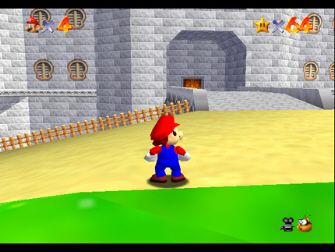
Super Mario 64 is so entertaining to play because the focus is simply on fun. There is no complex story here (hardly any story actually) although there are a few characters you can talk to. Mainly Toad’s that you will find scattered about the Castle (make sure to talk to them all because some of them will give you Secret Stars) and an occasional character in one of the levels, but outside of that all the text in the game is optional. You are simply told about a Star on the select screen and then you are off to get it!
There really isn’t much to find in the levels either, although you will encounter friendly pink colored Bomb-Ombs, known as Bomb-Omb Buddies that will give you access to a cannon in most stages, and the cannons can be used to shoot Mario to otherwise unreachable portions of the levels, as previously mentioned. You only have to talk to them once to open the cannon and then it’ll stay open no matter how many times you re-enter the level for Stars.

The goals in Super Mario 64 to get each Star are also quite diverse and this keeps the game from getting repetitive, even though you’re just searching for Stars the whole time. But generally no two Stars on any given level will be gotten in the same manner (although some are more well hidden than others). There are also several bosses you will encounter, and a few puzzles, but most Stars are pretty easy to figure out and rarely reach any kind of head-scratching.
There are a few levels that have you racing to get Stars, whether it’s racing “Koopa the Quick” to a certain portion of a level, racing a penguin down a slide, guiding a snowball or racing against your own time. And while you will encounter several Stars on levels that are pretty “out in the open” as mentioned above, others will require you to do something totally unique. One level has you breaking off part of a wall with a cannon shot by shooting Mario headfirst into it(!), revealing the Star. The first level has you pounding a stake in which subsequently frees a giant Chain Chomp, who then crashes into a closed cage that contains the Star. In one of the water levels you must follow the rings of a manta ray to earn the Star and in the second level you fly high into the sky in the talons of an owl that you can control and must drop yourself into a cage in the sky that’s holding a Star. And these are only a very select few of the things you will be doing to earn Stars.
Levels are generally pretty short, especially if you simply go straight for the Star and don’t bother with collecting coins. And as such some Stars can be obtained in a matter of minutes, although others will take longer. The later levels in particular, such as Wet Dry World, are more difficult. And while I wouldn’t say the game is hard by any stretch of the imagination, you will die. It’s almost always by falling off the stage, but for some Star goals you’ll die or fail a number of times before getting it right. Thankfully extra lives are easily obtainable. Not only can you get them through the classic green-colored 1-Up Mushrooms that you’ll find scattered about, but you will also obtain an extra life for every 50 coins that you collect (not 100 like in the previous Mario games).
And you will definitely be encouraged to grab coins. Every stage has a “Red Coin” Star where you’re required to collect 8 Red Coins scattered about the stage (although sometimes they are quite close together, depends on the level. Each one is different). And in addition to that, you also earn a Star for collecting 100 regular coins on any level. Every stage has one of these 100 Coin Stars, so to get all 120 Stars in the game and thus a 100% completion, you must make sure to grab the 100 Coin Star. This Star can be gotten at any time while you are hunting for another Star (these Stars don’t have a name of their own so you won’t select them from the Star Select screen, they will appear at the bottom though once you’ve gotten it) and when you get it the game allows you to save right then and there (or not save if you want) so you can continue hunting for the Star you selected.
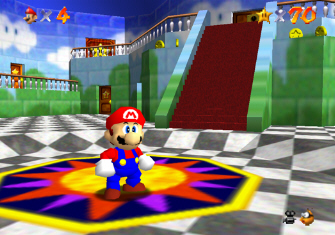
Actually one little bother about the game is the fact that when hunting a Star, you are forced back out of the level when you get it. So sometimes when hunting for the 100 Coin Star you will accidentally grab another regular Star and be forced out. Believe it or not this has happened when I had like 99 coins . . . and thus you are forced to do it all over again to get that 100 Coin Star. An easy fix to this would have been to allow you to Save right then and there when you get a Star, just like you can with the 100 Coin Star, and then continue on or Exit the level.
One interesting aspect of the game is that unlike in previous Mario’s coins aren’t all over the place . . . but rather there’s only a certain number of them, usually a little over 100, on each level. So usually the most difficult Star to obtain on a level is the 100 Coin Star, it’s easy to die before you reach that high of a number of coins because you have to search high and low for them, and many times you must also kill enemies so that they release the coins and add to your total. And obviously killing enemies also puts you in danger of dying.
Many stages also feature a Blue Coin block. Slamming this will make large Blue Coins appear for a limited time, in which you must collect them before they disappear. On many levels the only way to reach 100 Coins is to get all the Blue Coins. The difficulty of getting the Coins that appear varies. While on most levels they simply appear in a straight line, they get harder to obtain the further you are in the game. In the last level you must do a tremendous wall jump if you are to get all the Blue Coins. It’s fun collecting the coins though and it’s one of my favorite parts of the game, particularly because it’s one of the tougher parts of the game, to get 100 coins and get the 100 Coin Star.
Coins also emerge as one of the few classic Super Mario icons that re-appear in Super Mario 64. Completely gone are the typical breakable bricks and question mark blocks that you remember from past games.
Re-appearing is the 1-Up Mushroom (as mentioned above) and missing is the Super Mushroom, which allowed Mario to grow to a larger size. This of course was a significant part of the previous Mario games, from Super Mario Bros. on the NES to Super Mario World on the SNES. But in Super Mario 64 with it’s complete turn from 2D to 3D the Super Mushroom is missing and outside of one stage Mario never changes size. However Mario can lose his hat . . . which although it may seem to not effect anything it actually doubles the amount of damage you take from enemies. Being able to lose your hat is cool because you’ve never seen Mario’s hair before, and now that we could see the back of his head, it was definitely an interesting thing for Nintendo to do for Mario’s first 3D appearance.
 The biggest missing power-up from previous games is the Fire Flower, it is no where to be found in Super Mario 64, but what does return are the Red, Blue and Green “Cap Switches” which made their debut in Super Mario World. In that game you could find special color coded switches in certain levels, and when pressed they filled in blocks that were crucial in getting through the game (which was viewed from a side-scrolling 2D perspective) or in finding secrets. In Super Mario 64 the blocks remain but they basically take the place of the Question Mark block from past games.
The biggest missing power-up from previous games is the Fire Flower, it is no where to be found in Super Mario 64, but what does return are the Red, Blue and Green “Cap Switches” which made their debut in Super Mario World. In that game you could find special color coded switches in certain levels, and when pressed they filled in blocks that were crucial in getting through the game (which was viewed from a side-scrolling 2D perspective) or in finding secrets. In Super Mario 64 the blocks remain but they basically take the place of the Question Mark block from past games.
A lot of stages in Super Mario 64 feature one of these colored Cap Switch boxes, and they do not get filled in until you press the corresponding colored Switch, which like in Super Mario World you will have to find hidden somewhere in the game. Once found the corresponding blocks will turn solid, allowing you to hit them below and claim what’s inside.
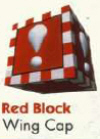 So what is inside these blocks you ask (as if you didn’t already know, eh)? Different hats of course! Which are Mario’s means of equipping himself with new powers in this game. And it is one of the coolest parts of Super Mario 64, the new power-ups. You will find the Wing Cap, Metal Cap and Vanish Cap. The Wing Cap gives Mario flight ability (adding Wings to his red hat), just like he had with Raccoon Mario in Super Mario Bros. 3 and his cape in Super Mario World. With a triple jump Mario will take to the skies and can fly anywhere around the stage, although all the Caps only last for a short amount of time before running out. And if you run out with the Wing Cap you better watch out! Cause you’ll come crashing to the ground!
So what is inside these blocks you ask (as if you didn’t already know, eh)? Different hats of course! Which are Mario’s means of equipping himself with new powers in this game. And it is one of the coolest parts of Super Mario 64, the new power-ups. You will find the Wing Cap, Metal Cap and Vanish Cap. The Wing Cap gives Mario flight ability (adding Wings to his red hat), just like he had with Raccoon Mario in Super Mario Bros. 3 and his cape in Super Mario World. With a triple jump Mario will take to the skies and can fly anywhere around the stage, although all the Caps only last for a short amount of time before running out. And if you run out with the Wing Cap you better watch out! Cause you’ll come crashing to the ground!
 And while flight is not new to Mario, it is given a completely different feel here in Super Mario 64, since Mario controls like an airplane. You have to push up on the stick to make him dive downward, and tilt down to make him go upward. He can be quite unwieldy particularly when trying to make him fly straight (he’ll automatically seem to speed up) or when trying to fly upward. But regardless it’s super fun to fly around as Wing Cap Mario and it’s easily one of the features of the game that stands out most.
And while flight is not new to Mario, it is given a completely different feel here in Super Mario 64, since Mario controls like an airplane. You have to push up on the stick to make him dive downward, and tilt down to make him go upward. He can be quite unwieldy particularly when trying to make him fly straight (he’ll automatically seem to speed up) or when trying to fly upward. But regardless it’s super fun to fly around as Wing Cap Mario and it’s easily one of the features of the game that stands out most.
As is the Metal Cap. This Cap turns Mario into solid metal and allows you to not only kill enemies by jumping into them or walk through fire without being hurt, but you can also walk on the bottom of any body of water since you sink. The solid look of metal Mario is very cool.
Finally you have the Vanish Cap for Vanish Mario, this cap allows Mario to walk through things, although only certain things, like grate fences. You can however also walk through any projectiles fired by enemies.
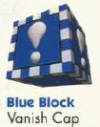 The Caps are a great part of Super Mario 64 but they aren’t actually used as often as you’d expect. Contrary to the Mario days of old where you were given multiple chances of getting at least one of the power-ups on each and every level in the game, there are several stages in Super Mario 64 where you will not use any of the three Caps.
The Caps are a great part of Super Mario 64 but they aren’t actually used as often as you’d expect. Contrary to the Mario days of old where you were given multiple chances of getting at least one of the power-ups on each and every level in the game, there are several stages in Super Mario 64 where you will not use any of the three Caps.
Also missing in Super Mario 64 are a lot of the characters from past games. Absent here are both Luigi and Yoshi, although Yoshi does pop up in a cameo appearance as an award for collecting all 120 Stars in the game. Luigi is no where to be found though and he’s not even mentioned! Which is just flat out criminal!
However both Princess Peach and Toad are featured prominently in the game. Toad is given a helping role, you will find him (or is it multiple Toads?) scattered around the castle, ready to dole out information or random exposition that helps give the game a bit more character. He will also occasionally give you one of the Castle’s Secret Stars, so make sure to always talk to Toad, who is typically huddled away in the corner of the room.
Also making his mark on the Super Mario 64 world is Bowser. Obviously he was the one who kidnapped Princess Peach in the first place and has hidden her off somewhere inside the castle. Mario of course has to return the power of the Power Stars to the castle to bring her back. You will face off against Bowser a total of three times and Bowser is in awesome form in this game, having grown in size to at least triple the height and mass of Mario. In order to beat bowser you will need to grab onto his tail with the B Button and then twirl him around by rotating the control stick. You can then fling him off into several bombs placed around the platform which will destroy him.
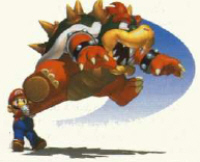 Sadly the Bowser fights aren’t that difficult, although the Koopa King (that’s Bowser for the un-educated) does have a number of cool moves, from spitting out fire to pounding the ground to teleportation. When you defeat Bowser you will receive a key that allows you to gain access to another whole section of the castle that was previously unexplorable.
Sadly the Bowser fights aren’t that difficult, although the Koopa King (that’s Bowser for the un-educated) does have a number of cool moves, from spitting out fire to pounding the ground to teleportation. When you defeat Bowser you will receive a key that allows you to gain access to another whole section of the castle that was previously unexplorable.
And Bowser isn’t the only boss you will face off against as I’ve mentioned. Super Mario 64 contains quite a few classic boss fights although none of them are very difficult. They vary from a face-off with a giant Wiggler, to a giant Bob-Omb, to a giant slab of concrete. The boss fights are always fun just over way too quickly, and I wish that there were more of them. But what’s here is nice.
As far as enemies go, a lot of the classic Mario enemies of old returned in 3D form here, and many of them are done differently thanks to the move from 2D to 3D. Returning enemies include:
Goomba – Which look freakish in 3D. These bald guys will get startled if you move near them and then rush into you. They are actually quick little buggers and can be sometimes hard to smoosh. Like in the Mario’s of old the easiest way to dispose of them is to simply jump on their heads, but you can also punch to send them flying. Always fun.
 Bomb-Omb – These classic, bombastic enemies will light their fuse and give chase if you get too near. You can pick up and throw them as well and the blast created will destroy any enemies that get in it’s vicinity. They also appear in pink as the good guy Bom-Omb Buddies as mentioned many times, and these guys are crucial allies as they are the only way to gain access to cannons in the levels.
Bomb-Omb – These classic, bombastic enemies will light their fuse and give chase if you get too near. You can pick up and throw them as well and the blast created will destroy any enemies that get in it’s vicinity. They also appear in pink as the good guy Bom-Omb Buddies as mentioned many times, and these guys are crucial allies as they are the only way to gain access to cannons in the levels.
Koopa Troopa – The classic Mario foes will offer their shells (that you can ride) if you can manage to jump on top of them, popping the little Koopa out. When ridding a shell any enemies you run into will be destroyed and the shell will keep sliding until you run into a wall or object. Once on a shell there’s also no way to jump off it. Sometimes you’ll also find Koopa shells hidden inside boxes and you can even find them underwater. Sadly you will not encounter any Para Troopa’s in Super Mario 64, which would’ve been fitting with Mario’s new wings. Killing a Koopa will net you a blue coin.
Piranha Plant – These pipe-popping enemies are no longer connected to pipes and now appear on their own. You can only destroy them by jumping on their heads or punching them when they are asleep, and you have to tiptoe as to not wake them up. You get a blue coin for your efforts.
Bullet Bill – These black bullets don’t appear in Super Mario 64 as often as you’d expect, and they now come super sized. Bullet Bills aren’t destructable anymore either, so you better run if you see one coming towards you.
Chain Chomp – This guy only appears once in the game in very large variety. He’s a nasty creature, don’t get too close!
Pokey – The infamous Cactus enemies (as first made popular in Super Mario Bros. 2) are made up of several round cactus pieces and look quite formidable in 3D. Killing one will net you a blue coin. The easiest way to dispose of them is to simply side-flip onto their heads, but you can also destroy each segment with a punch or kick if you so desire.
Lakitu – Not always friendly, you will actually encounter enemy Lakitu from time to time. They look quite cool in 3D and can be difficult to actually destroy, which is easist to do by jumping on them. They will drop spiked enemies like always and give you a blue coin for killing one.
Thwomp – Ahhh Thwomps, who doesn’t love them?! They look very weird here, naked really. They are solid blue and lack any spikes which makes them much less threatening. They also seem to have an expression that changes. The pyramid level gives you some interesting mummy-like varieties of Thwomps. Generally these enemies attack so slow that they aren’t much of a threat, but you will take lots of damage if you are smushed by one.
Boo – And finally we come to Boo’s. These are easiest to kill with a Butt Stomp and appear in both small and large forms, although almost exclusively on the Haunted House level. The Big Boo’s kind of work as a boss, although they aren’t any harder than the smaller forms really. Kept inside of Boo’s is a blue coin that you can collect for banishing them back to the nether-realm.
The newer enemies in the game generally pop-up as themed depending on the level. For instance in the snow stages you will face-off with little snowmen that will throw snowballs at you. In the haunted house stage and on a few others you will encounter large eyes that can shoot you. To destroy both enemies you must run in circles around them (and as such showing off the analog controls of Mario 64). One of the coolest new enemies appears on the second stage. These are small versions of the boss and are walking slabs of concrete. The only way to destroy them is to get in front of them so they slam down, trying to squish you. On their backs is a large white X, and if you pound their backs while they are down they will be destroyed.
Graphically, Super Mario 64 obviously looks quite dated in comparison to the games nowadays or even from the GameCube generation. Matter of fact, with it’s blurry and simplistic textures, the game looks quite horrible at first (especially when you play the very first stage, Bomb-Omb Battlefield). But as you play you will not only get used to the graphics and focus more on how colorful the game is, but the levels seem to improve in graphical quality as you play (in addition to the stages becoming more complex).
 So it shouldn’t be too difficult for you to look past the outdated graphics and focus on what’s really important, the outstanding gameplay. The camera however can be a bit troublesome, although typically you can rotate it some but it does have issues with getting hung up on walls every now and again and blocking your view, but it’s not a huge problem and doesn’t come up as often as you’d think. You also have the myriad of camera options previously explained, so even if it does get hung up, you can simply press the R Button to bring it in close then press it again and the camera will be reset.
So it shouldn’t be too difficult for you to look past the outdated graphics and focus on what’s really important, the outstanding gameplay. The camera however can be a bit troublesome, although typically you can rotate it some but it does have issues with getting hung up on walls every now and again and blocking your view, but it’s not a huge problem and doesn’t come up as often as you’d think. You also have the myriad of camera options previously explained, so even if it does get hung up, you can simply press the R Button to bring it in close then press it again and the camera will be reset.
The music and sound effects in Super Mario 64 are fantastic. Although there are very few remixes from Mario’s past (you will hear the underground tune in Hazy Maze Cave, but it’s not really recognizable enough to stand out as a remix) which is a major bummer, but there are some really great tunes in the game. From the water music to the really cool Bowser tunes, the music in Super Mario 64 doesn’t disappoint.
And the sound effects are equally as good. Mario’s voices are classic and perfect (“Mama-mia!” he’ll say when you get knocked out of a picture) and really go a long way in making Mario even more likeable than he already was in the past games. He will even fall asleep if you leave him still and don’t move the control stick and if you leave him like that long enough he’ll start dreaming and talking in his sleep! Back in 1996 that was really cool, and even now it still gives you a laugh. The coin collecting sounds, 1-Up sound and such are also all as you remember and the sound design of Mario 64 perfectly matches the on-screen action.
In conclusion, Super Mario 64 is simple, flat-out, unadulterated fun. The game is quite long and will last you over 20 hours and even more if you have never played the game. And even if you have, it’s so fun that it’s easily recommended to give it a replay if you haven’t touched the game in years. From the outstanding design of the levels to Mario’s extensive move list, there really is nothing to complain about here, even though the game lacks any kind of multiplayer mode and is absent of Luigi! You simply can’t go wrong with Super Mario 64, even in the year 2008 the gameplay will not disappoint.
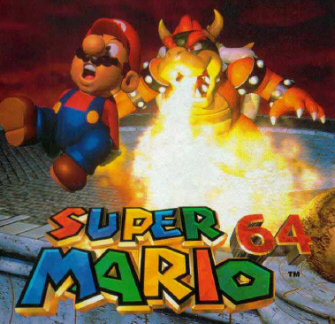
FUN FACTOR: 10
Super Mario 64 is a blast to play and has enough Stars to last you days upon days of classic 3D Mario fun. Every level seems to be funner than the last and by the time you reach the final few stages you will be quite shocked that the game can still remain not only fun but original and fresh with unique gameplay moments from beginning to end. The last few levels truly demonstrate how great the level design in the game is and all these levels will stick with you long after you’ve turned the power off. You almost don’t want it to end.
Graphics: 8.0
At first they don’t look so great, but after a while you begin to appreciate how much care was put into this game and how colorful and good it looks despite the blurry and simplistic textures and how old it is. It truly does stand up to the test of time well considering that it was one of the very first fully 3D games.
Music & Sound: 9.5
The music in Super Mario 64 is outstanding and the sound effects and voice of Mario could not be more perfect. I only wish there was some more remixes of classic Mario tunes, but the new ones are outstanding.
Ingenuity: 9.5
For it’s time Super Mario 64 literally changed the landscape of the video game industry much like Nintendo had with Super Mario Bros. on the NES. A fully 3D world with analog stick control and a huge number of moves that make Mario a truly acrobatic showcase that is still impressive even today. Although Super Mario 64 may look cliche and par for the course as far as platformers are concerned in this day and age, it is in reality the game that started the platformer revolution. The fact that it still seems impressive today and remains no less fun proves just how amazing of a feat of pure design genius Super Mario 64 was (All hail Shigeru Miyamoto!).
Presentation: 8.0
No complaints here, from the Star Select Screen to the intro with Mario’s head and the File Select Screen, Super Mario 64 is presented to the player just fine.
Replay Value: 8.0
Although Super Mario 64 lacks any kind of multiplayer mode to speak of, the game has enough Stars, 120, that it will take you a long time to get them all even if you know where all of them are. And if you don’t, expect the amount of play time it will take you to get them all to double, anywhere from 30 to 40 hours if I had to guess. That’s a lot of Mario! You will not be disappointed.




